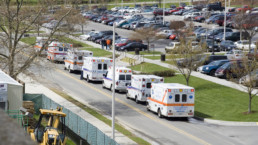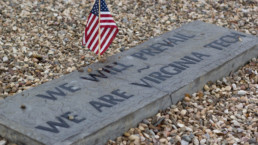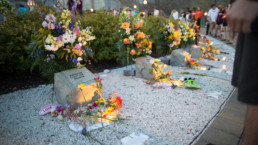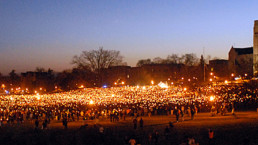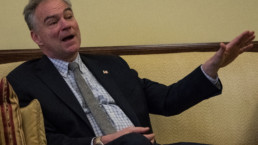In orientation for graduate teaching assistants (GTAs) we learn how not to violate our students’ FERPA rights, how not to violate our students’ Title IX rights and how not to violate our students. Orientation for GTAs is an 8-hour long day of 30-minute mini sessions related to the topics listed above with nothing but decaf coffee and a slice of pizza to shake things up. And still, when a Virginia Tech police lieutenant said the date “April 16,” I stiffened in my seat and focused my attention as if it were mini-session one.
Lt. Tony Haga of the VTPD explained to a Colonial Hall bursting with new GTAs the importance of identifying and, when necessary, addressing a red flag. He explained, handing three index cards to three different GTAs, that each of us as teachers may know something about a specific student. “Family troubles,” read one index card, a potential red flag noticed by a single GTA. “Recent break-up,” read another index card, in another GTAs exclusive possession. “Academic struggles,” read a third card, yet another GTAs private knowledge. These three facts about a single student are seemingly harmless, manageable, not worth mentioning when separated as such.
Just as several faculty members separately noticed red flags in Seung-Hui Cho’s behavior.
I realized, for the first time, the responsibility that falls not only on full-time faculty and tenured professors, but also on GTAs.
I thought about my four years at Virginia Tech as a student sitting in 20-person English courses concerned only with coasting my way through efficiently enough that the professor couldn’t tell I never read. Then I thought about standing in front of a 20-person English course concerned that one of my students failed to attend class for an entire week, concerned that one of my students submitted a writing exercise full of violent imagery, concerned that one of my students might kill someone if I don’t stop it from happening.
In the midst of Haga’s anecdote about befriending students in need of support, I observed the incoming class of GTAs. Of the 650 plus of us in Colonial Hall that morning, the majority did not look up from phone screens, did not close prematurely purchased textbooks, did not awaken from seated slumbers. As far as I could tell, none of the graduate students seated around me were sharing my moment of alarmed revelation.
As an alumna, as someone who attended Virginia Tech for four years as an undergraduate, I realized I understood April 16 differently than any GTA arriving in Blacksburg who entered a VT classroom and experienced the Hokie community for the first time this academic year. While I was not here in 2007, I still understood standing on the Drillfield with a candle in front of the memorial. I still understood everything encompassed in the moment of silence before the 3.2 for 32. I still understood the weight of what happened here. And I understood the weight that was now on us.
CAPABLE OF ANYTHING
“I distinctly remember, I was sitting in art history one day, and that was in Torg 1000 something. So the stage was at the bottom, there was stadium, graduated seating and there were doors at the bottom and up at the top. And I recall one day, a student coming in the door that was at the back of the classroom, which was at the top of the stairs. It rarely ever happened, if ever. Students always came in the front. And I remember seeing a look of panic on my professor’s face. The first thing that came into my mind was, yeah, that must be terrifying … what must go through your mind of what could be coming through that door.”
Amanda McGlone attended Virginia Tech for her undergraduate degree from 2010–14 before returning in the fall 2014 semester for graduate school and a position as a graduate teaching assistant. She completed her master’s in 2016 and began as a full-time instructor with the English department in the fall 2016 semester. As her role in the Virginia Tech community evolved, so did the impact of April 16 on her everyday life.
As an undergraduate, McGlone came to Virginia Tech with a sense of heightened vigilance.
“Once I was a student here, I just have a lot of memories of being very hyper-aware because it was only three years since the event had happened, and it was very much in the forefront of my mind as I was sitting in classes,” McGlone said. “As the years went on, my hyper-awareness sort of drifted away. I got more comfortable. As I said, I think the April 16 events started to drop off the further we got away from 2007. So it seemed to be on the forefront of my mind less as I continued on with my undergraduate degree.”
During McGlone’s post-graduate academic work, her relationship with April 16 shifted.
“Interestingly, once I got to grad school, it became less this sort of sympathy, and I began to get defensive,” McGlone said. “What I mean by that is I became part of a cohort with students who were not from Virginia or were not from this part of Virginia. So I had lots of different people that I was meeting who were not part of the Virginia Tech undergraduate student body, and did not know about the rhetoric, the way we talk about it, or the way we think about it, the way that we live it every day on this campus. And I started to get really defensive wanting those students to know that this campus is safe.”
Again, once McGlone became an instructor, the passive hyperawareness from her early years in Blacksburg returned, but in a more active sense to fit her active role as an instructor.
“I think back to what I saw when I was a freshman, and that teacher who looked panicked when the door opened, and now I’m that teacher,” McGlone said. “As a teacher, I definitely feel like April 16 has been part of the way that I approach my classroom and my students, to ensure I keep them safe and myself safe on an everyday basis … I’m not sure I would have that kind of vigilance if I wasn’t teaching at this university or hadn’t been part of the student body for so long.”
McGlone reflected on how the events of April 16 have impacted her life in different ways over the years.
“It’s been an interesting progression. I feel like as a student I had a lot of passive emotions. I felt a lot of things, and I felt sadness, and I felt hope, and I felt something, but all of those were passive things. I wasn’t doing anything … So I went from being this very passive undergraduate to a teacher who really felt like they were ready to act if need be.”
McGlone attended a similar GTA orientation session in the fall of 2014 and then another human resources (HR) daylong orientation before she began working as a full-time instructor.
“When I was a GTA, I went through that workshop, and I can’t for the life of me remember what was said to me,” McGlone said. “There were hundreds of GTAs there, whereas in my HR training, it was a very small classroom. The police officer was standing two rows in front of me, right in front of me, and I remember so many things he told us.”
In addition to being in a more intimate setting, she attended the HR workshop immediately before she began teaching in the fall. The same does not go for the GTA orientation.
“It is worth nothing, I know not every department is like this, but in the English department, we attend that workshop before the fall semester starts of our first year, but we don’t go into the classroom until the spring semester … so we get all this knowledge that’s meant to stick with us, but we don’t put it into practice for an entire semester, an entire three or four months,” McGlone said.
McGlone suggests changes that could be made in order to help better prepare GTAs.
“If we’re thinking about how do we reform or how do we prepare our teachers, particularly our GTAs, for going into the classroom and how we present this to them, can we present this information to them in smaller groups? Can we ensure that there is a closer relationship between the students getting this information and the police officer talking to them?
“Then again, I think there is that issue of how much can you prepare someone for something like that,” McGlone said. “And if that actually happened, would that police officer’s voice be in the back of my head, or would I be working on pure instinct and adrenaline? It’s probably the latter.”
Consistent with McGlone’s hypothesis, when she found out last academic year that one of her students had allegedly murdered a 13-year-old girl, the red flag training she and I both received proved frighteningly useless.
David Eisenhauer, the Virginia Tech student accused of killing Nicole Lovell last January, took McGlone’s ENGL 1105 course in the fall and had just begun spring semester coursework in McGlone’s ENGL 1106 course when he was arrested.
“Hindsight was not 20/20. I didn’t have that moment where I looked back and thought, ‘Wow, I missed all those things that would have told me that he would have been arrested and all those things would have happened,’” McGlone said. “In fact, I looked back and thought he’s just like all the other students that I teach, or many of them. He has a similar major, similar way he participated in class, a similar temperament to the other students I teach. He didn’t stand out to me in any way.”
While both the GTA and HR training attempted to provide instructors with the skills to recognize students capable of these types of acts of violence, Eisenhauer exhibited none of the signs we were taught to see.
“In that way, it’s taught me that my students could be capable of anything. No matter what. Even if there is no red flag, even if there is nothing that tells me, ‘Hey, this student might be struggling with something or they might be capable of something like this,’ that threat is always present,” McGlone said. “His case in particular was so evident of that, because not only was he arrested for this crime, but I also saw him after he supposedly committed it. He came back to my classroom and sat in class even after it happened. Not only was he capable of that, he was capable of coming back and going on about his school day as if nothing happened. That shows me my students are capable of anything.”
McGlone taught Eisenhauer for an entire semester prior to his arrest. As English instructors and GTAs, we’ve been told that we may be the only teachers who know our students’ names. Apart from our 20-person English course, freshman students may have nothing but 300-person plus lecture halls, classes in which they are nothing more than their student ID numbers. We know their names. If any faculty member is to notice a red flag, we have been told, it will be us. But what if there’s nothing to notice?
“It’s changed my view of my students in the way that nothing has changed. I have no action to take,” McGlone said. “I have no more knowledge than I had before, but it at least makes me that much more aware of what my students are capable of, not only to other members in the community, but to each other.”
THERE WAS NOTHING
Edward Falco, author and English professor with Virginia Tech’s MFA program, had Cho as a student.
“It was very odd. He didn’t speak at all in class, and so the first thing I did was try to talk to him afterwards … I remember he was clearly different,” Falco said. “One of the things you’ll do with a student who is inward and not communicating is you might initiate some contact. And I remember putting my hand on his arm, and instead of the kind of opening up you might feel he just sort of shut down, locked up. Obviously he didn’t like it, so I took my hand away. Immediately.”
Falco taught Cho’s playwriting class the semester of April 16, 2007, and recounted the experience of slowly discovering the shooter was one of his students.
“We slowly got little bits and pieces of information about who did the shooting, and as the bits and pieces of information came in, it looked more and more like it was one of our students,” Falco said. “The description, the details we were getting, and as we were putting the pieces together there was this growing anxiety that it would be this particular student. And then we eventually found out it was.”
Falco said he never had any concerns about Cho harming others or himself.
“No. No. There was nothing he ever did that indicated that could be an issue.”
Similar to McGlone’s comments about Eisenhauer, Falco reiterated multiple times throughout the interview that Cho showed none of the red flags that would have provided some warning of what was to come. No change to Falco’s classroom management or teaching methods would have altered the events that would soon transpire so, in line with McGlone’s experience, Falco’s teaching ideologies remained unchanged after April 16.
“We had a lot of discussions about and a lot of back and forth about recognizing danger signals in students and how to handle disturbing writing, but again, none of those pertained to the shooter. None of them pertained to him. He didn’t give any indications that there were in any way, that there was some sort of issue,” Falco said.
Falco refrained from using Cho’s name for the entirety of the interview.
Ed Falco
Professor Ed Falco speaks about the impact April 16, 2007, had on the Virginia Tech community.
Specifically in creative writing courses, in which students are encouraged to express the full spectrum of emotions, identifying potentially dangerous situations becomes further complicated.
“We began talking about what if a student turns in disturbing writing. It’s a very complicated issue for creative writers because writing can be violent. Just because you write something that’s violent doesn’t mean that you’re violent,” Falco explained. “So you often get writing that’s violent, and you don’t want to be in the position where you have to turn people into the system because they’ve written something that’s violent. Plus, you need freedom, and you need a place where you can write what you need without worrying about being turned into somebody in the creative writing community.”
While Cho’s writing was violent, it did not warrant any alarm.
“There was some violence in his plays. But it was the kind of juvenile violence. It’s like beginning artists drawing skulls and crossbones. That kind of juvenile rather than sophisticated. And there was nothing in it that stood out and said, ‘There’s some danger here.’”
"Mr. Brownstone," one of two plays submitted to AOL News by Cho's classmate, Ian MacFarlane.
The second play submitted to AOL News by MacFarlane, entitled "Richard McBeef."
As tenured professors, faculty instructors and GTAs, we are provided with training to spot red flags that, on at least two occasions, have arguably failed to exist.
“There’s a distinction obviously. If somebody writes hate-filled writing, and you can see the hatred in it, and that person seems dangerous then I think any creative writing person would take a step with that. Talk to the student and then talk to others, but that happens so rarely. Hardly ever happens,” Falco explained, reiterating again that these types of warning signs were not exhibited by the shooter.
He went on to explain the dangers of attempting to take on the role of another profession in the pursuit of these types of indicators.
“We put ourselves in a very dangerous position if we pretend that we’re not teachers but psychologists and psychiatrists, and that’s not what we’re trained to do,” Falco said. “We’re not trained in those fields. We’re trained to examine writing and see how it’s working from a literary perspective.”
Falco described the events of the day as “a horror story just sort of injecting itself into your life.” When asked if he ever felt guilty after hearing that the shooter was one of his own students, Falco responded without hesitation.
“Heartbroken is better than guilty. There’s nothing to feel guilty about. There was no way of knowing what was going to happen. Nobody could have guessed what was going to happen. There’s no way anybody could have assumed. No reason to have assumed. So no. I didn’t feel guilty. I felt terribly, but not guilty, no.”
Falco sent out an email to his students soon after the shooting that conveyed this message to a class he knew might experience feelings of guilt.
“The gist of what I said was it doesn’t do anybody any good to review, to take on a sense of guilt over what happened. Nothing happened in that classroom that they could have changed.
“He was a strange student. And that’s all we knew about him,” Falco continued. “You don’t want to live in a world where somebody who’s strange suddenly gets ostracized from the community … There’s got to be room in the world for odd people and for people who don’t fit. You don’t pull them all out and stick them in a corner some place.”
SAY SOMETHING, SAY NOTHING
Both McGlone and Falco stood in the front of a room of students and attempted to teach accused murderers how to write. Both discovered the incomprehensibly horrible capabilities of these students. Both recalled a lack of warning signs in the students; the red flags that I, as a GTA, was trained to spot as a means of protecting both my students and myself from harm.
In Cho’s case, he exhibited what other English department faculty did identify as red flags worth communicating. Lucinda Roy, the chair of the Department of English at the time of the shootings, now an MFA instructor alongside Falco, wrote a book in 2009 titled “No Right to Remain Silent” in which she provides an examination of how the university handled both Cho and the events of April 16.
“It is the story of a university hampered both by its own labyrinthine bureaucracy and by the dogged determination of its administration to protect itself,” Roy wrote. “It is about a system of public education in dire need of reform — one which, in the case of Virginia Tech, resulted in conflicts of interest and a chronic inability to respond swiftly to crisis situations.”
Roy worked one-on-one with Cho after Nikki Giovanni asked that he be removed from her class, and Giovanni was not the only one who had concerns about him.
“He had been taken over, actually. One of the professors, Lisa Norris, offered to walk him over to the counseling center. And others had offered to help him in any way they could in terms of getting counseling for his issues,” Falco said. “I knew that others had already done those kinds of interventions, but not because they were worried about him hurting anybody. He obviously had some sort of issue, some sort of developmental issue that kept him from speaking.”
Even Roy voiced concerns that were ultimately not addressed.
“I had reported my concerns about this student to various units across campus, letting them know that he seemed depressed and angry. I had worked with him myself when it seemed there was no other viable alternative. I had struggled to get him into counseling.”
Unfortunately, Roy wrote that any help response Cho received from Cook Counseling was “tragically inadequate.”
Some faculty members saw no threat from Cho, said nothing about him, and the events of April 16 occurred.
Some faculty members saw Cho as a threat, said something about him, and the events of April 16 occurred.
As tenured professors, faculty instructors and GTAs today, 10 years later, the question still remains. Can the threat assessment training required of all teachers at Virginia Tech adequately prepare us to handle these extreme situations of danger? Is it even possible to be adequately prepared for those types of situations?
Ten years after the deadliest school shooting in U.S. history, some of my first-year composition students do not know what happened here on April 16. They crack open the classroom door, arriving 20 minutes late and have no idea that I contemplate, if only for less than a second, the full range of horrors that could be coming through my door. They point out the dangling cord from the digital clock display and don’t wonder whether the unplugged cord means we will miss an impending emergency alert, this time not broadcasting as a drill. They hear the same bang in the hallway that I do, but while they remain half awake and bored out of their minds, I pause mid-lecture, sure it was the first bang of hundreds.

